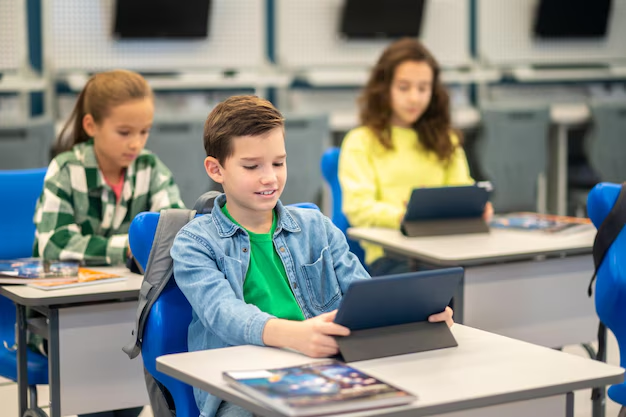The landscape of education is undergoing a significant transformation. Traditional classroom settings are being replaced or enhanced with technology, providing students and teachers with new opportunities for growth and innovation. From digital learning tools to online courses, the way we approach education has evolved dramatically. In this article, we will explore the shift from traditional methods to tech-savvy education and the impact of this change on students, educators, and learning outcomes.
Keywords: traditional education, tech-savvy education, educational technology, digital learning tools, online learning, modern classrooms, future of education, digital classrooms, technology in education, tech-driven learning, e-learning, educational innovation
1. The Traditional Education System: A Legacy of Conventional Learning
For centuries, education has primarily relied on traditional methods such as face-to-face instruction, textbooks, and chalkboards. This conventional approach has served generations of students and is still the foundation of many educational systems around the world.
- Teacher-Centered Instruction: Traditional classrooms focus on the teacher as the central figure, delivering lectures and guiding students through lessons in a structured environment.
- Textbook-Based Learning: The use of textbooks and written materials has been the primary source of content for students, often limiting learning to static, one-dimensional information.
- Key Point: While traditional education has provided foundational knowledge, it is increasingly being complemented or replaced by more dynamic, tech-savvy methods.
- Further Detail: The traditional approach to education tends to be rigid, with limited flexibility in terms of learning speed, subject engagement, and access to resources.
Keywords: traditional education, teacher-centered learning, textbook-based education, conventional classrooms, rigid learning methods
2. The Role of Technology in Revolutionizing Education
Technology has become an integral part of modern education, offering innovative tools and platforms that enhance both teaching and learning experiences. These advancements provide new ways for students to access information, collaborate, and engage with educational content.
- Digital Learning Tools: Tools like interactive whiteboards, tablets, and online resources make learning more engaging and interactive for students.
- Online Learning Platforms: Websites such as Coursera, Khan Academy, and edX provide students with access to a vast array of courses, giving them the opportunity to learn at their own pace.
- Cloud-Based Learning: Cloud technology allows students and educators to share and access educational materials anytime, anywhere, breaking down geographical barriers and creating a more accessible education system.
- Key Point: Technology is making education more interactive, flexible, and accessible, offering students opportunities to learn beyond traditional classroom settings.
- Further Detail: The integration of digital tools into the learning process is helping create personalized educational experiences tailored to each student’s needs.
Keywords: technology in education, digital learning, online learning platforms, cloud-based education, EdTech, interactive learning tools, digital classrooms
3. Online Education: A Shift Toward Remote Learning

The rise of online education has revolutionized how students and educators engage with learning materials. The flexibility of remote learning enables students to access courses, assignments, and educational content from any location, making education more adaptable to diverse lifestyles.
- Flexibility in Learning: Students can access lessons on-demand, allowing them to learn at their own pace, manage their schedules, and tailor their educational experiences.
- Global Access to Education: Online learning breaks down geographical barriers, offering opportunities for students from all over the world to gain knowledge from top universities and instructors.
- Key Point: Online education provides flexibility and accessibility, democratizing education for students worldwide.
- Further Detail: The growing availability of online resources means that students no longer have to be physically present in a classroom to access quality education.
Keywords: online education, remote learning, flexible learning, digital education, e-learning, online courses, global education
4. Tech-Savvy Classrooms: Embracing Smart Education
In modern classrooms, technology is no longer just an addition – it is the backbone of the learning experience. Smart classrooms integrate devices and platforms that enable interactive, personalized learning, creating an environment where students and teachers can collaborate seamlessly.
- Interactive Whiteboards and Tablets: These devices allow for dynamic lessons, where both students and teachers can interact with the material in real-time, making learning more engaging.
- Learning Management Systems (LMS): Platforms like Google Classroom and Moodle allow teachers to organize assignments, track progress, and facilitate collaboration between students.
- Key Point: The use of smart devices and LMS platforms in classrooms is revolutionizing how students learn and engage with their lessons.
- Further Detail: The integration of technology into the classroom allows students to participate in digital discussions, collaborate on projects, and receive immediate feedback on assignments.
Keywords: smart classrooms, interactive whiteboards, learning management systems, digital devices in education, tech-driven classrooms, smart education
5. The Benefits and Challenges of Tech-Savvy Education
While the benefits of tech-savvy education are clear, there are also challenges that come with the transition from traditional methods. Understanding both sides is essential to making the most of this shift in education.
- Benefits:
- Personalized Learning: Technology allows for a more tailored educational experience, where students can learn at their own pace and receive targeted support.
- Enhanced Collaboration: Digital tools facilitate collaboration among students and educators, fostering a more dynamic learning environment.
- Increased Engagement: Interactive tools such as educational apps, games, and VR can engage students in ways that traditional methods may not.
- Challenges:
- Digital Divide: Not all students have access to the necessary devices or high-speed internet, which can create disparities in access to digital education.
- Over-Reliance on Technology: There is a risk of becoming overly dependent on technology, potentially detracting from face-to-face social interactions and critical thinking skills.
- Key Point: Embracing tech-savvy education offers numerous benefits, but it requires addressing challenges like accessibility and balancing technology with traditional learning methods.
- Further Detail: As educational technology continues to evolve, it’s crucial to find solutions to these challenges to ensure that all students have equal opportunities to benefit from tech-driven learning.
Keywords: benefits of technology in education, challenges in digital education, digital divide, personalized learning, interactive learning, online learning challenges
6. The Future of Education: A Balance Between Tradition and Technology
As we look to the future, education will likely be a blend of traditional methods and tech-savvy innovations. While technology will continue to play a key role in education, traditional learning practices that emphasize social interaction, critical thinking, and emotional intelligence will remain vital.
- Hybrid Learning Models: A combination of in-person and online learning will become more common, allowing students to experience the best of both worlds.
- Technology-Enhanced Traditional Methods: Teachers will continue to use technology to enhance their lessons, ensuring that students benefit from both modern tools and tried-and-true learning techniques.
- Key Point: The future of education will be a hybrid model that leverages the strengths of both traditional and digital learning methods.
- Further Detail: As education evolves, we must ensure that technology complements, rather than replaces, essential elements of traditional education.
Keywords: hybrid learning models, future of education, balanced learning, digital and traditional education, blended learning, educational evolution
Also Read : The Digital Classroom: How Technology Is Redefining Education
Conclusion
The shift from traditional to tech-savvy education is more than just a trend – it’s a fundamental transformation that is reshaping how we learn and teach. With digital tools, online platforms, and smart classrooms, education is becoming more personalized, flexible, and accessible. As technology continues to advance, the challenge will be to balance innovation with traditional methods to ensure that students receive the best possible education.
Keywords: changing education landscape, tech-savvy learning, future of education, technology in classrooms, digital transformation in education, personalized learning, educational evolution
SEO Optimization Tips:
- Keyword Integration: Use keywords like “tech-savvy education,” “digital classrooms,” “traditional learning,” and “online education” throughout the article for optimal SEO.
- Header Tags: Properly format headings (H1, H2, H3) to improve the article’s structure for search engines and make it easier for users to navigate.
- Internal Links: Link to related articles or blog posts to increase engagement and time spent on your website.
- Alt Text for Images: If using images, include alt text descriptions that include relevant keywords to boost SEO.





